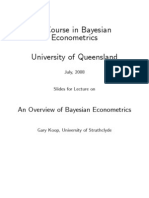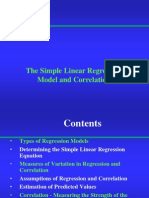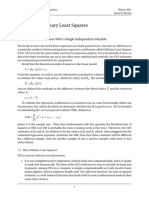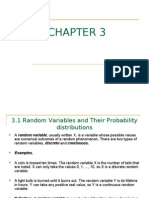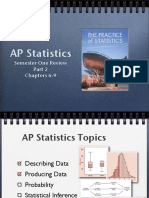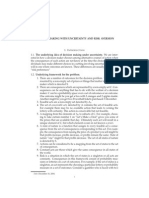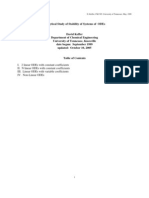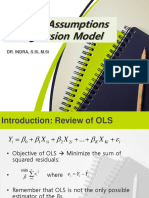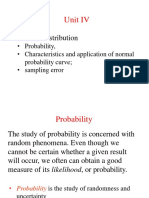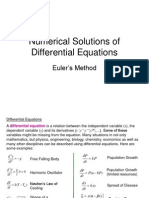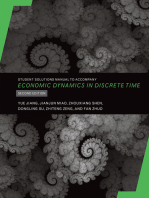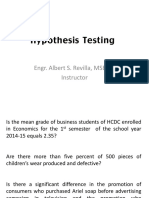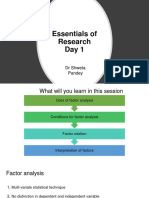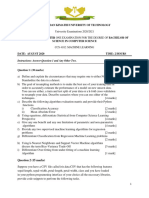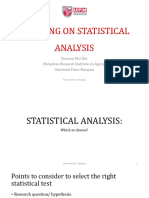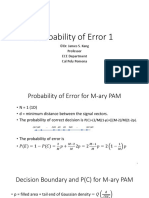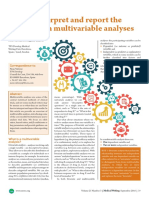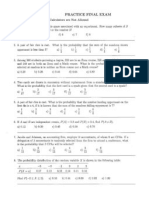1 The Econometrics of The Simple Regression Model: I 1 1i 2 2i K Ki I
1 The Econometrics of The Simple Regression Model: I 1 1i 2 2i K Ki I
Uploaded by
Rubayyat HashmiCopyright:
Available Formats
1 The Econometrics of The Simple Regression Model: I 1 1i 2 2i K Ki I
1 The Econometrics of The Simple Regression Model: I 1 1i 2 2i K Ki I
Uploaded by
Rubayyat HashmiOriginal Title
Copyright
Available Formats
Share this document
Did you find this document useful?
Is this content inappropriate?
Copyright:
Available Formats
1 The Econometrics of The Simple Regression Model: I 1 1i 2 2i K Ki I
1 The Econometrics of The Simple Regression Model: I 1 1i 2 2i K Ki I
Uploaded by
Rubayyat HashmiCopyright:
Available Formats
1 The Econometrics of the Simple
Regression Model
Multiple regression model with I explanatory vari-
ables:
Y
i
= c + o
1
A
1i
+ o
2
A
2i
+ .. + o
I
A
Ii
+ .
i
,
where i subscripts to denote individual observations and
we have i = 1, .., . observations.
In econometrics, lots of uncertainty.
Uncertain what the regression coecients, c, o
1
, .., o
I
are (and, hence, have to estimate them).
Uncertain whether a hypothesis (e.g. o
)
= 0) is
true (and, hence, have to derive hypothesis testing
procedures).
We are uncertain about what future values of Y
might be (and, hence, have to derive procedures for
forecasting).
Probability provides us with a language and a formal
structure for dealing with uncertainty.
In this chapter, we will use probability to do some
key statistical derivations.
To keep formulae simple, will work with simple re-
gression model (i.e. regression model with one ex-
planatory variable) with no intercept:
j
i
= oA
i
+ .
i
where i = 1, .., . and A
i
is a scalar.
Derivations for multiple regression model are con-
ceptually similar but formulae get complicated (use
of matrix algebra usually involved)
1.1 A Review of Basic Concepts in Proba-
bility in the Context of the Regression
Model
See Appendix B for details, here we present basic
ideas informally.
Assume Y is a random variable.
Regression model provides description about what
probable values for the dependent variable are.
E.g. Y is the price of a house and A is a size of
house.
What if you knew that A = 5000 square feet (a
typical value in our data set), but did not know Y
A house with A = 5000 might sell for roughly
$70, 000 or $60, 000 or $50, 000 (which are typical
values in our data set), but it will not sell for $1, 000
(far too cheap) or $1, 000, 000 (far too expensive).
Econometricians use probability density functions (p.d.f.)
to summarize which are plausible and which are im-
plausible values for the house.
Figure 3.1 is example of a p.d.f.: tells you range of
plausible values which Y might take when A =
5, 000.
Figure 3.1 a Normal distribution
Bell-shaped curve. The curve is highest for the most
plausible values that the house price might take.
Chapter 1 introduced the ideas of a mean (or ex-
pected value) and variance.
The mean is the "average" or "typical" value of a
variable
Variance as being a measure of how dispersed a vari-
able is.
The exact shape of any Normal distribution depends
on its mean and its variance.
"Y is a random variable which has a Normal p.d.f.
with mean j and variance o
2
" is written:
Y .
_
j, o
2
_
Figure 3.1 has j = 61.153 $61, 153 is the mean,
or average, value for a house with a lot size of 5, 000
square feet.
o
2
= 683.812 (not much intuitive interpretation
other than it reects dispersion range of plausible
values)
P.d.f.s measure uncertainty about a random variable
since areas under the curve dened by the p.d.f. are
probabilities.
E.g. Figure 3.2. The area under the curve between
the points 60 and 100 is shaded in.
Shaded area is probability that that the house is
worth between $60, 000 and $100, 000.
This probability is 45% and can be written as:
Pr (60 Y 100) = 0.45.
Normal probabilities can be calculated using statis-
tical tables (or econometrics software packages).
By denition, the entire area under any p.d.f. is 1.
1.1.1 Expected Value and Variance
In this book, we are repeatedly using expected value
and variance operators.
Best way to learn these is through reading/doing
problem sets.
The expected value of A, denoted 1 (A), can be
interpreted as an average or typical value that might
occur.
Expected value is also called the mean, often denoted
by the symbol j. Thus, j = 1 (A).
The variance
ov (A) = 1
_
(A j)
2
_
= 1
_
A
2
_
j
2
The standard deviation is the square root of the vari-
ance.
Variance and standard deviation are commonly-used
measures of dispersion of a random variable.
Covariance between two random variables, A and
Y , dened as:
cc (A, Y ) = 1 (AY ) 1 (A) 1 (Y ) .
Covariance best motivated through correlation be-
tween A and Y :
ccvv (A, Y ) =
cc (A, Y )
_
ov (A) ov (Y )
.
Correlation is degree of association between two ran-
dom variables. It satises 1 ccvv (A, Y ) 1
with larger positive/negative values indicating stronger
positive/negative relationships between A and Y .
If A and Y are independent, then ccvv (A, Y ) = 0.
1.1.2 Properties of Expected Values and Variance
If A and Y are two random variables and o and b are
constants, then:
1. 1 (oA + bY ) = o1 (A) + b1 (Y )
2. ov (Y ) = 1 (Y ) [1 (Y )]
2
3. ov (oY ) = o
2
ov (Y )
4. ov (o + Y ) = ov (Y )
5. cc (A, Y ) = 1 (AY ) 1 (A) 1 (Y )
6. ov (oA + bY ) = o
2
ov (A)+b
2
ov (Y )+2obcc (A, Y )
7. 1 (AY ) ,= 1 (A) 1 (Y ) unless cc (A, Y ) = 0.
8. If A and Y Normally distributed then o.
i
+ b.
2
is
also Normal. "Linear combinations of Normals are
Normal".
These properties generalize to the case of many random
variables
1.1.3 Using Normal Statistical Tables
Table for standard Normal distribution i.e. . (0, 1)
is in textbook.
Can use . (0, 1) tables to gure out probabilities for
the .
_
j, o
2
_
for any j and o
2
.
If Y .
_
j, o
2
_
, what are mean and variance of
Z =
Y j
o
.
As an example of a proof using properties of expected
value operator:
1 (Z) = 1
_
Y j
o
_
=
1 (Y j)
o
=
1 (Y ) j
o
=
j j
o
= 0.
As an example of a proof using properties of variance:
ov (Z) = ov
_
Y j
o
_
=
ov (Y j)
o
2
=
ov (Y )
o
2
=
o
2
o
2
= 1.
Thus, Z is . (0, 1) and we can use our statistical
tables
Z is often referred to as a Z-score.
For any random variable, if you subtract o its mean
and divide by standard deviation always get a new
random variable with mean zero and variance one
Example: In Figure 3.2 how did we obtain
Pr (60 Y 100) = 0.45
Remember Figure 3.2 has Y . (61.153, 683.812).
Pr (60 Y 100)
= Pr
_
60j
o
Y j
o
100j
o
_
= Pr
_
6061.153
_
683.812
Y 61.153
_
683.812
10061.153
_
683.812
_
= Pr (0.04 Z 1.49)
.
Now probability involves the standard Normal distri-
bution
Normal statistical tables say Pr (0.04 Z 1.49) =
0.45.
Details: break into two parts as
Pr (0.04 Z 1.49)
= Pr (0.04 Z 0) + Pr (0 Z 1.49)
From table Pr (0 Z 1.49) = 0.4319.
But since the Normal is symmetric Pr (0.04 Z 0) =
Pr (0 Z 0.04)=0.0160.
Adding these two probabilities together gives 0.4479
1.2 The Classical Assumptions for the Re-
gression Model
Now let us return to the regression model.
We need to make some assumptions to do any statistical
derivations and start with the classical assumptions
1. 1 (Y
i
) = oA
i
.
2. ov (Y
i
) = o
2
.
3. cc
_
Y
i
, Y
)
_
= 0 for i ,= ).
4. Y
i
is Normally distributed
5. A
i
is xed. It is not a random variable.
Compact notation: Y
i
are independent .
_
oA
i
, o
2
_
.
An equivalent way of writing the classical assumptions is:
1. 1 (.
i
) = 0 mean zero errors.
2. ov (.
i
) = 1
_
.
2
i
_
= o
2
constant variance errors
(homoskedasticity).
3. cc
_
.
i
.
)
_
= 0 for i ,= ).
4. .
i
is Normally distributed
5. A
i
is xed. It is not a random variable.
1.3 Motivation for Classical Assumptions
Regression model ts a straight-line through an XY-
plot.
1 (Y
i
) = oA
i
is the linearity assumption.
Second assumption: all observations have the same
variance (homoskedasticity).
Ex. where this might not be a good assumption.
House price data. Small houses all the same. Big
houses more diverse. If so, house prices might be
more diverse for big houses (heteroskedasticity).
Third assumption: observations uncorrelated with one
another.
This assumption is usually reasonable with cross-
sectional data (e.g. in a survey, response of person1
and person 2 are unrelated).
For time series data not a good assumption (e.g.
interest rate now and last month are correlated with
one another)
Fourth assumption (Y is Normal), harder to moti-
vate.
In many empirical applications, Normality is reason-
able.
Asymptotic theory can be used to relax this assump-
tion. We will not cover this in this course (but see
Appendix C and Appendices at end of several chap-
ters)
Fifth assumption (explanatory variable not a random
variable) is good in experimental sciences, but maybe
not in social sciences.
We will talk about relaxing these assumptions in later
chapters.
1.4 The Ordinary Least Squares (OLS) Es-
timator of o
j
i
= oA
i
+ .
i
OLS estimator is chosen to minimize:
.
i=1
.
2
i
This can be done using calculus.
o =
.
i=1
A
i
j
i
.
i=1
A
2
i
1.4.1 Properties of OLS Estimator
o =
A
i
j
i
A
2
i
=
A
i
(A
i
o + .
i
)
A
2
i
= o +
A
i
.
i
A
2
i
(*)
Property 1: OLS is unbiased under the classical as-
sumptions
1
_
o
_
= o
Proof:
1
_
o
_
= 1
_
_
o +
A
i
.
i
A
2
i
_
_
= o + 1
_
_
A
i
.
i
A
2
i
_
_
= o +
1
A
2
i
1
_
A
i
.
i
_
= o +
1
A
2
i
A
i
1 (.
i
)
= o
Use equation (*) and properties of expected value opera-
tor. Remember A
i
is not random (hence can be treated
as a constant).
Property 2: Variance of OLS estimator under the
classical assumptions
ov
_
o
_
=
o
2
A
2
i
Proof:
ov
_
o
_
= ov
_
_
o +
A
i
.
i
A
2
i
_
_
= ov
_
_
A
i
.
i
A
2
i
_
_
=
_
_
1
A
2
i
_
_
2
ov
_
A
i
.
i
_
=
_
_
1
A
2
i
_
_
2
A
2
i
ov (.
i
)
=
_
_
1
A
2
i
_
_
2
o
2
A
2
i
=
o
2
A
2
i
Use equation (*) and properties of variance operator. Re-
member A
i
is not random (hence can be treated as a
constant).
Property 3: Distribution of OLS estimator under
classical assumptions
o is .
_
_
o,
o
2
A
2
i
_
_
Proof: Properties 1 and 2 plus "linear combinations of
Normals are Normal" theorem.
Property 3 is important since it can be used to derive
condence intervals and hypothesis tests.
The OLS estimator is a random variable and has a p.d.f.
Ex. Figure 3.3 if
o is . (2, 1)
Want your estimator to be unbiased and want it to have
as small a variance as possible.
An unbiased estimator is said to be ecient relative to
another if it has a smaller variance.
Property 4: The Gauss-Markov Theorem
If the classical assumptions hold, then OLS is the best,
linear unbiased estimator,
where best = minimum variance
linear = linear in y.
Short form: "OLS is BLUE"
Note: the assumption of Normal errors is NOT required
to prove Gauss-Markov theorem. Hence, OLS is BLUE
even if errors are not Normal.
Property 5: Under the Classical Assumptions, OLS
is the maximum likelihood estimator
Maximum likelihood is another statistical principal for
choosing estimators.
Textbook has a discussion of this topic, but I do not have
time to cover in lectures.
1.4.2 Deriving a Condence Interval for o
Assume o
2
known (discuss relaxing this assumption later).
Use Property 3 to obtain:
Z =
o o
_
o
2
A
2
i
is . (0, 1)
Then can use statistical tables for the Normal distribution
to make probability statements. For instance,
Pr [1.96 Z 1.96] = 0.95
To get 95% condence interval, rearrange the inequalities
to put o in the middle:
Pr
_
_
1.96
o o
_
o
2
A
2
i
1.96
_
_
= 0.95
rearranging:
Pr
_
_
o 1.96
_
o
2
A
2
i
o
o + 1.96
_
o
2
A
2
i
_
_
= 0.95
Note:
o is a random variable, o is not a random variable.
Hence, we do not say "probability interval" but rather
"condence interval".
95% condence interval is
_
_
o 1.96
_
o
2
A
2
i
o
o + 1.96
_
o
2
A
2
i
_
_
commonly written as:
o 1.96
_
o
2
A
2
i
Other condence levels can be handled by getting dif-
ferent number from Normal tables. For instance, 90%
condence interval would replace "1.96)" by "1.64" in
previous equations.
1.4.3 Hypothesis tests about o
Assume o
2
known (discuss relaxing this assumption later).
Basic idea in testing any hypothesis, 1
0
:
The econometrician accepts 1
0
if the calculated value
of the test statistic is consistent with what could plausibly
happen if 1
0
is true.
List the general steps in hypothesis testing along with the
specic steps for this case.
Step1: Specify a hypothesis, 1
0
.
1
0
: o = o
0
(where o
0
is known, usually o
0
= 0)
Step 2: Specify a test statistic
Z =
o o
_
o
2
A
2
i
Step 3: Figure out distribution of test statistic assuming
1
0
is true.
Z =
o o
0
_
o
2
A
2
i
is . (0, 1) .
Step 4: Choose a level of signicance (usually 5%).
0.05
Step 5: Use Steps 3 and 4 to get a critical value.
Critical value = 1.96 (from Normal statistical tables)
Step 6: Calculate your test statistic and compare to crit-
ical value. Reject 1
0
if absolute value of test statistic is
greater than critical value (else accept H
0
).
Reject if [Z[ 1.96.
1.5 Modications when o
2
is unknown
o
2
appears in previous formula for condence interval and
test statistic. What to do when it is unknown?
1.5.1 Estimation of o
2
Residuals:
.
i
= j
i
oA
i
Unbiased estimator of o
2
is
c
2
=
.
2
i
. 1
Property (not proved in this course):
1
_
c
2
_
= o
2
.
Note: The . 1 in denominator becomes . I 1
in multiple regression where I is number of explanatory
variables.
1.5.2 Condence interval for o when o
2
unknown
Replace o
2
by c
2
in equations from earlier section "De-
riving a Condence Interval for o".
Nothing changes, except:
Z =
o o
_
o
2
A
2
i
is . (0, 1)
is replaced by:
Z =
o o
_
c
2
A
2
i
is t (. 1) ,
where t (. 1) is the Student-t distribution with N-1
degrees of freedom. And must use Student-t statistical
tables instead of Normal.
See Appendix B for instruction in using Student-t tables.
Example:
Suppose we have . = 21.
Before (with o
2
known) we derived
o 1.96
_
o
2
A
2
i
.
Now we have to look in t(20) row of Student-t statistical
tables and obtain:
o 2.08
_
c
2
A
2
i
.
1.5.3 Hypothesis testing about o when o
2
unknown
Replace o
2
by c
2
in equations from earlier section "Hy-
pothesis tests about o".
Nothing changes, except test statistic:
Z =
o o
0
_
o
2
A
2
i
is . (0, 1)
is replaced by:
Z =
o o
0
_
c
2
A
2
i
is t (. 1) ,
where t (. 1) is the Student-t distribution with N-1
degrees of freedom.
Must use Student-t statistical tables instead of Normal
to get critical value.
1.5.4 Note on P-values
All relevant computer packages now present P-values for
hypothesis tests. This means you do not need to look
up critical values in statistical tables (so no emphasis on
tables in this course).
Useful (but not quite correct) intuition: "P-value is the
probability that 1
0
is true"
A correct interpretation: "P-value equals the smallest level
of signicance at which you can reject 1
0
"
Example: If P-value is .04 you can reject 1
0
at 5% level
of signicance or 10% or 20% (or any number above 4%).
You cannot reject 1
0
at 1% level of signicance.
Common rule of thumb:
Reject 1
0
if P-value less than .05.
1.6 Chapter Summary
The major points and derivations covered in this chapter
include:
1. The manner in which the Normal distribution (which
is characterized by a mean and variance) is used in
the context of the simple regression model.
2. The introduction of the classical assumptions, from
which all else in this chapter is derived.
3. The properties of the OLS estimator, including a
proof that it is unbiased and a derivation of its dis-
tribution (i.e.
o is .
_
_
o,
o
2
A
2
i
_
_
).
4. The Gauss-Markov theorem which says OLS is BLUE
under the classical assumptions.
5. The derivation of a condence interval for o (assum-
ing o
2
is known).
6. The derivation of a test of the hypothesis that o = 0
(assuming o
2
is known).
7. The OLS estimator of o
2
.
8. How the condence interval and hypothesis test are
modied when o
2
is unknown.
You might also like
- A. K. Basu - Introduction To Stochastic ProcessDocument430 pagesA. K. Basu - Introduction To Stochastic Processearthboy_1100% (2)
- Chapter 1Document17 pagesChapter 1Getasew AsmareNo ratings yet
- Panel CookbookDocument98 pagesPanel CookbookMaruška VizekNo ratings yet
- Lesson 2: Multiple Linear Regression Model (I) : E L F V A L U A T I O N X E R C I S E SDocument14 pagesLesson 2: Multiple Linear Regression Model (I) : E L F V A L U A T I O N X E R C I S E SMauricio Ortiz OsorioNo ratings yet
- Ordinary Least SquaresDocument21 pagesOrdinary Least SquaresRahulsinghooooNo ratings yet
- A Course in Bayesian Econometrics University of QueenslandDocument22 pagesA Course in Bayesian Econometrics University of QueenslanddeustomanNo ratings yet
- The Simple Linear Regression Model and CorrelationDocument64 pagesThe Simple Linear Regression Model and CorrelationRajesh Dwivedi100% (1)
- Regression Analysis 01Document56 pagesRegression Analysis 01IRPS100% (5)
- AP Stats 6.1 LectureDocument28 pagesAP Stats 6.1 LectureLindsay CowdinNo ratings yet
- 2 Classical Linear Regression Models: 2.1 Assumptions For The Ordinary Least Squares RegressionDocument18 pages2 Classical Linear Regression Models: 2.1 Assumptions For The Ordinary Least Squares RegressionJiya SharmaNo ratings yet
- The Simple Regression ModelDocument41 pagesThe Simple Regression ModelDeniz Senturk OzcanNo ratings yet
- Metrics Aug 2023Document10 pagesMetrics Aug 2023Ahmed leoNo ratings yet
- Emet2007 NotesDocument6 pagesEmet2007 NoteskowletNo ratings yet
- Chapter 4: Probability Distributions: Discrete Random Variables Continuous Random VariablesDocument64 pagesChapter 4: Probability Distributions: Discrete Random Variables Continuous Random VariablesDaNo ratings yet
- Eco StatDocument11 pagesEco StatRani GilNo ratings yet
- Topic20 8p7 GalvinDocument53 pagesTopic20 8p7 GalvinJude SantosNo ratings yet
- Lesson Plan PPT (Ict in Math)Document23 pagesLesson Plan PPT (Ict in Math)Jennifer EugenioNo ratings yet
- PCA A Simple Principal Component Analysis ExampleDocument9 pagesPCA A Simple Principal Component Analysis ExampleAmr YassinNo ratings yet
- Topic 2Document58 pagesTopic 2Justin DeleonNo ratings yet
- Chapter 16Document6 pagesChapter 16maustroNo ratings yet
- CHAPTER THREE_ Multiple Linear Regression AnalysisDocument77 pagesCHAPTER THREE_ Multiple Linear Regression AnalysisdemilieNo ratings yet
- SST307 CompleteDocument72 pagesSST307 Completebranmondi8676No ratings yet
- 6.1: Discrete and Continuous Random VariablesDocument24 pages6.1: Discrete and Continuous Random VariablesJen Mamuyac-CastilloNo ratings yet
- Ordinary Least Squares With A Single Independent VariableDocument6 pagesOrdinary Least Squares With A Single Independent VariablenaeemNo ratings yet
- Chapter 3Document40 pagesChapter 3Tedros TesfawNo ratings yet
- Introduction To Mathematical EconomicsDocument164 pagesIntroduction To Mathematical Economics.cadeau01No ratings yet
- Chapter 1 - Linear Regression With 1 Predictor: Statistical ModelDocument35 pagesChapter 1 - Linear Regression With 1 Predictor: Statistical ModelgeeorgiNo ratings yet
- F5 Add Math Folio (Normal Distribution)Document28 pagesF5 Add Math Folio (Normal Distribution)Yuki Tan0% (1)
- MODULE 1 - Random Variables and Probability DistributionsDocument12 pagesMODULE 1 - Random Variables and Probability DistributionsJimkenneth RanesNo ratings yet
- Matrix OLS NYU NotesDocument14 pagesMatrix OLS NYU NotesAnonymous 2g4jKo5a7vNo ratings yet
- BasicsDocument61 pagesBasicsmaxNo ratings yet
- Unit 4Document8 pagesUnit 4Kamlesh PariharNo ratings yet
- Chapter 3Document39 pagesChapter 3api-3729261No ratings yet
- 340 Printable Course NotesDocument184 pages340 Printable Course NotesYidi LinNo ratings yet
- LM Week1 1 2019Document28 pagesLM Week1 1 2019Neel PatelNo ratings yet
- 2101 F 17 Assignment 1Document8 pages2101 F 17 Assignment 1dflamsheepsNo ratings yet
- Lecture3 221109 035214Document87 pagesLecture3 221109 035214indrahermawanNo ratings yet
- Stat331-Multiple Linear RegressionDocument13 pagesStat331-Multiple Linear RegressionSamantha YuNo ratings yet
- Notes in Ge 8 (MMW) - Normal CurveDocument6 pagesNotes in Ge 8 (MMW) - Normal CurveKathlyn Joy DulayNo ratings yet
- Probability: 201A: Econometrics I Peter E. Rossi Anderson School of ManagementDocument25 pagesProbability: 201A: Econometrics I Peter E. Rossi Anderson School of Managementgokuler137No ratings yet
- Review6 9Document24 pagesReview6 9api-234480282No ratings yet
- Simple Regression (Continued) : Y Xu Y XuDocument9 pagesSimple Regression (Continued) : Y Xu Y XuCatalin ParvuNo ratings yet
- Decision UncertaintyDocument19 pagesDecision Uncertaintycrinaus2003No ratings yet
- Chap7 Random ProcessDocument21 pagesChap7 Random ProcessSeham RaheelNo ratings yet
- ODE StabilityDocument20 pagesODE Stabilitybaraksh4No ratings yet
- Session-Classical AssumptionDocument26 pagesSession-Classical Assumptionhilmiazis15No ratings yet
- Unit 4Document45 pagesUnit 4Viji MNo ratings yet
- Basics of The OLS Estimator: Study Guide For The MidtermDocument7 pagesBasics of The OLS Estimator: Study Guide For The MidtermConstantinos ConstantinouNo ratings yet
- Review 2Document10 pagesReview 2Anastasia Monica KhunniegalshottestNo ratings yet
- MAE 300 TextbookDocument95 pagesMAE 300 Textbookmgerges15No ratings yet
- The Big Problems FileDocument197 pagesThe Big Problems FileMichael MazzeoNo ratings yet
- Jan S Dy 4Document26 pagesJan S Dy 4Hassan SaadNo ratings yet
- Numerical Solutions of Differential Equations: Euler's MethodDocument9 pagesNumerical Solutions of Differential Equations: Euler's MethodVinayaga Murthy GNo ratings yet
- Normal DistributionDocument40 pagesNormal DistributionaishaheavenNo ratings yet
- Eigenvalue EigenvectorDocument69 pagesEigenvalue EigenvectordibyodibakarNo ratings yet
- Basic Probability Reference Sheet: February 27, 2001Document8 pagesBasic Probability Reference Sheet: February 27, 2001Ibrahim TakounaNo ratings yet
- Applications of Derivatives Errors and Approximation (Calculus) Mathematics Question BankFrom EverandApplications of Derivatives Errors and Approximation (Calculus) Mathematics Question BankNo ratings yet
- Student Solutions Manual to Accompany Economic Dynamics in Discrete Time, second editionFrom EverandStudent Solutions Manual to Accompany Economic Dynamics in Discrete Time, second editionRating: 4.5 out of 5 stars4.5/5 (2)
- Student's Solutions Manual and Supplementary Materials for Econometric Analysis of Cross Section and Panel Data, second editionFrom EverandStudent's Solutions Manual and Supplementary Materials for Econometric Analysis of Cross Section and Panel Data, second editionNo ratings yet
- AE 413 Lecture 5 - Forecsating Typologies 2023-2024-1Document12 pagesAE 413 Lecture 5 - Forecsating Typologies 2023-2024-1Jamali AdamNo ratings yet
- Questions Short Concept QuestionsDocument61 pagesQuestions Short Concept QuestionsNg Win WwaNo ratings yet
- Hypo LecDocument79 pagesHypo LecMicka EllahNo ratings yet
- ContinuousProbabilityDistribution NormalDocument35 pagesContinuousProbabilityDistribution NormalS LuNo ratings yet
- Auto/cross-Correlation: Generalized Regression ModelDocument37 pagesAuto/cross-Correlation: Generalized Regression ModeljiosNo ratings yet
- 18MAB303T - RegressionDocument97 pages18MAB303T - RegressionJEMINA J (RA2011037010010)No ratings yet
- Session 1.4 Factor Analysis NotesDocument23 pagesSession 1.4 Factor Analysis NotesArwin Siy LaysonNo ratings yet
- RAY 0115 BiostatisticsWhitepaper 8.5x11 WEBDocument14 pagesRAY 0115 BiostatisticsWhitepaper 8.5x11 WEBrexvillavelezNo ratings yet
- Theory of Measurements and ErrorsDocument36 pagesTheory of Measurements and ErrorsYamiyoNo ratings yet
- CCS 4102 Machine Learning Examinations-August 2020Document2 pagesCCS 4102 Machine Learning Examinations-August 2020Kefa MwitaNo ratings yet
- Training On Statistical AnalysisDocument109 pagesTraining On Statistical AnalysisphoolanranisahaniNo ratings yet
- MLStackCafe QAS 1672810525772Document12 pagesMLStackCafe QAS 1672810525772venkatNo ratings yet
- Steps For Hypothesis TestingDocument3 pagesSteps For Hypothesis TestingBishnu S. MukherjeeNo ratings yet
- Probability of Error 1Document26 pagesProbability of Error 1Huy NguyenNo ratings yet
- Travel Demand Forecasting 2Document13 pagesTravel Demand Forecasting 2Sheikh UbaidNo ratings yet
- WorksheetsDocument35 pagesWorksheetsWasif ImranNo ratings yet
- How To Interpret and Report The Results From Multi Variable AnalysisDocument6 pagesHow To Interpret and Report The Results From Multi Variable AnalysisSofia Batalha0% (1)
- Chapter4.Time Series DecompositionDocument42 pagesChapter4.Time Series DecompositionLe HieuNo ratings yet
- Gravity Model FinalDocument19 pagesGravity Model FinalElon MuskNo ratings yet
- Exercise # 6 Ailyn O. LabajoDocument5 pagesExercise # 6 Ailyn O. LabajoAilyn LabajoNo ratings yet
- Paper 3 Style Question With The Marking Scheme 4Document4 pagesPaper 3 Style Question With The Marking Scheme 4huiyibao87No ratings yet
- Data PreparationDocument12 pagesData PreparationKhari haranNo ratings yet
- 1690 Past PapersDocument21 pages1690 Past PapersdavogezuNo ratings yet
- Probability PPT GroupDocument78 pagesProbability PPT GroupRiyasen UNo ratings yet
- Biostatistics - Epidemiology Book 2023 (B&B) (Medicalstudyzone - Com)Document52 pagesBiostatistics - Epidemiology Book 2023 (B&B) (Medicalstudyzone - Com)Vincent DaoNo ratings yet
- Multiple Linear Regression 2021Document45 pagesMultiple Linear Regression 2021notepadhajarNo ratings yet
- HOMEWORK 3 Rishabh AroraDocument6 pagesHOMEWORK 3 Rishabh AroraRishabh AroraNo ratings yet
- Stochastic Models: Stochastic Processes: Bernoulli Process, Poisson Process)Document11 pagesStochastic Models: Stochastic Processes: Bernoulli Process, Poisson Process)mod nodNo ratings yet
- Descriptive StatisticsDocument19 pagesDescriptive StatisticsFrancis NyekoNo ratings yet





